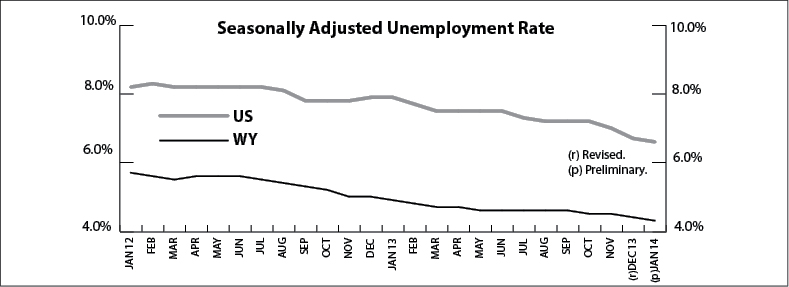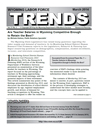Wyoming Unemployment Rate Falls to 4.3% in January 2014
The Research & Planning section of the Wyoming Department of Workforce Services reported that the state’s seasonally adjusted1 unemployment rate fell from 4.4% in December to 4.3% in January. Wyoming’s unemployment rate has been trending downward for the past four years, and remains significantly lower than the current U.S. unemployment rate of 6.6%. Seasonally adjusted employment of Wyoming residents rose, increasing by 1,961 individuals (0.7%) from December to January.
Nearly all county unemployment rates followed their normal seasonal pattern and increased from December to January. Seasonal job losses are often seen in January in many sectors, including construction, retail trade, professional & business services, and government. The largest unemployment rate increases were seen in Washakie (up from 4.2% to 5.5%), Lincoln (up from 5.9% to 7.1%), and Fremont (up from 5.6% to 6.6%) counties. Teton County’s unemployment rate fell from 6.4% in December to 4.7% in January as the winter tourist season got into full swing.
From January 2013 to January 2014, unemployment fell in every county, suggesting continued improvement in the state’s economy. Unemployment decreased by a full percentage point or more in 15 of the state’s 23 counties. The largest decreases occurred in Teton (down from 6.4% to 4.7%), Sheridan (down from 7.3% to 5.8%), and Crook (down from 6.5% to 5.0%) counties.
The lowest unemployment rates were found in Sublette (3.6%), Converse (3.7%), and Campbell (4.0%) counties. Lincoln County posted the highest unemployment rate (7.1%). It was followed by Fremont (6.6%), Johnson (6.6%), Big Horn (6.2%), and Park (6.2%) counties.
Total nonfarm employment (measured by place of work) rose from 280,200 in January 2013 to 283,700 in January 2014, a gain of 3,500 jobs (1.2%).
1Seasonal adjustment is a statistical procedure to remove the impact of normal regularly recurring events (such as weather, major holidays, and the opening and closing of schools) from economic time series to better understand changes in economic conditions from month to month.

